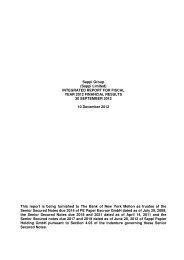2007 Annual Report - Sappi
2007 Annual Report - Sappi
2007 Annual Report - Sappi
Create successful ePaper yourself
Turn your PDF publications into a flip-book with our unique Google optimized e-Paper software.
2.3.8 Inventories<br />
Inventories are assets held-for-sale in the ordinary course of<br />
business, in the process of production for such sale or in the<br />
form of materials or supplies to be consumed in the production<br />
process or in the rendering of services.<br />
Inventories are stated at the lower of cost or net realisable value.<br />
Cost includes all costs of purchase, costs of conversion and<br />
other costs incurred in bringing the inventories to their present<br />
location and condition. Net realisable value is the estimated<br />
selling price in the ordinary course of business, less the<br />
estimated cost of completion, distribution and selling.<br />
Cost is determined on the following basis:<br />
• First-in-first-out (FIFO): finished goods<br />
• Weighted average: raw materials, work-in-progress and<br />
consumable stores<br />
• The specific identification basis is used to arrive at the cost<br />
of items that are not interchangeable.<br />
The cost of raw materials and consumable stores is the<br />
delivered landed cost, while the cost of work-in-progress<br />
and finished goods includes both direct costs and production<br />
overheads.<br />
2.3.9 Leases<br />
(i) The group as lessee<br />
Leases in respect of which the group bears substantially all the<br />
risks and rewards incidental to ownership are classified as<br />
finance leases. Finance leases are capitalised at the inception<br />
of the lease at the lower of the fair value of the lease property<br />
or the present value of the minimum lease payments. Each<br />
lease payment is allocated between the liability and finance<br />
charges to achieve an effective rate of interest on the balance<br />
outstanding. The corresponding rental obligations, net of<br />
finance charges, are included in other long-term payables. The<br />
interest element of the finance cost is charged to profit or loss<br />
over the lease period.<br />
Capitalised leased assets are depreciated on a consisent basis<br />
as those with owned assets except where the transfer of<br />
ownership is uncertain at the end of the lease period in which<br />
case they are depreciated on a straight line basis over the shorter<br />
of the lease period and the expected useful life of the asset.<br />
Leases in respect of which a significant portion of the risks and<br />
rewards of ownership are retained by the lessor are classified<br />
as operating leases. These leases are mainly for the use of<br />
premises and certain office equipment. Payments made under<br />
operating leases (net of any incentives received from the lessor)<br />
are charged to income on a straight line basis over the term<br />
of the lease. When another systematic basis is more<br />
representative of the time pattern of the user’s benefit, then that<br />
method is used.<br />
(ii) Recognition of lease of land<br />
Leases of land and buildings are classified as operating or<br />
finance leases in the same way as leases of other assets.<br />
However, when a single lease covers both land and a building,<br />
the minimum lease payments at the inception of the lease<br />
(including any upfront payments) are allocated between the land<br />
and the building in proportion to the relative fair values of the<br />
respective leasehold interests. Any upfront premium allocated<br />
to the land element that is normally classified as an operating<br />
lease represents prepaid lease payments. These payments are<br />
amortised over the lease term in accordance with the time<br />
pattern of benefits provided. If the lease payments cannot be<br />
allocated reliably between these two elements, the entire lease<br />
is classified as a finance lease, unless it is clear that both<br />
elements are operating leases.<br />
2.3.10 Non-current assets held for sale and<br />
discontinued operations<br />
Non-current assets (or disposal groups) are classified as held<br />
for sale when their carrying value will be recovered principally<br />
through sale within 12 months rather than use. Non-current<br />
assets held for sale are measured at the lower of carrying<br />
amount and fair value less cost to sell and are not depreciated.<br />
A discontinued operation is a clearly distinguishable component<br />
of the group’s business that has been disposed of or is held for<br />
sale within 12 months of initial identification, which:<br />
• represents a separate line of a major line of business or<br />
geographical area of operations;<br />
• is part of a single coordinated plan to dispose of a major line<br />
of business or geographical area of operations; or<br />
• is a subsidiary acquired exclusively with a view to resale<br />
within 12 months.<br />
The entire asset or disposal group must be available for<br />
immediate sale in its present condition and the sale should be<br />
highly probable, with an active programme to find a buyer and<br />
the appropriate level of management approving the sale. The<br />
group does not currently have any discontinued operations.<br />
sappi limited | 07 | annual report 81
















